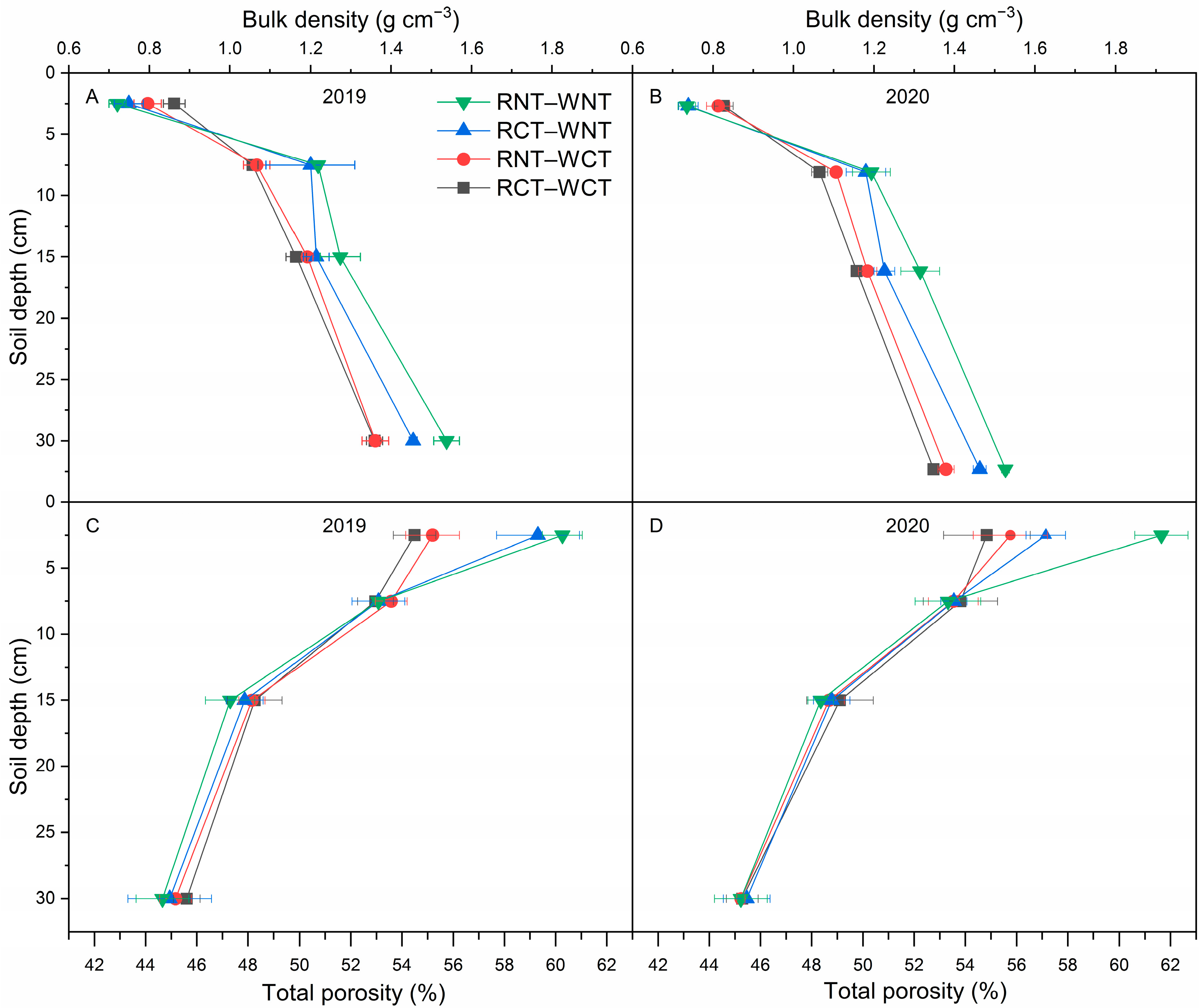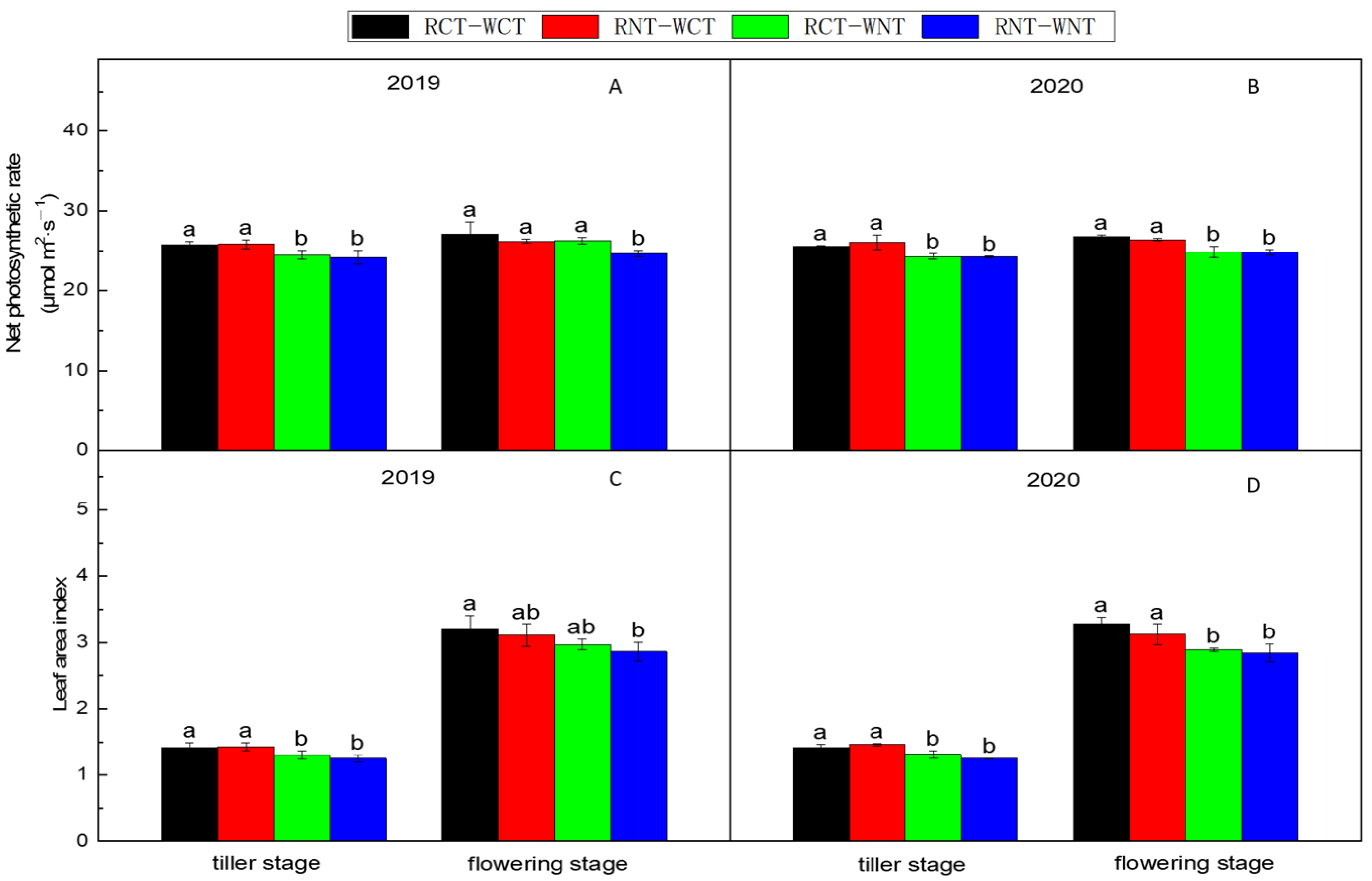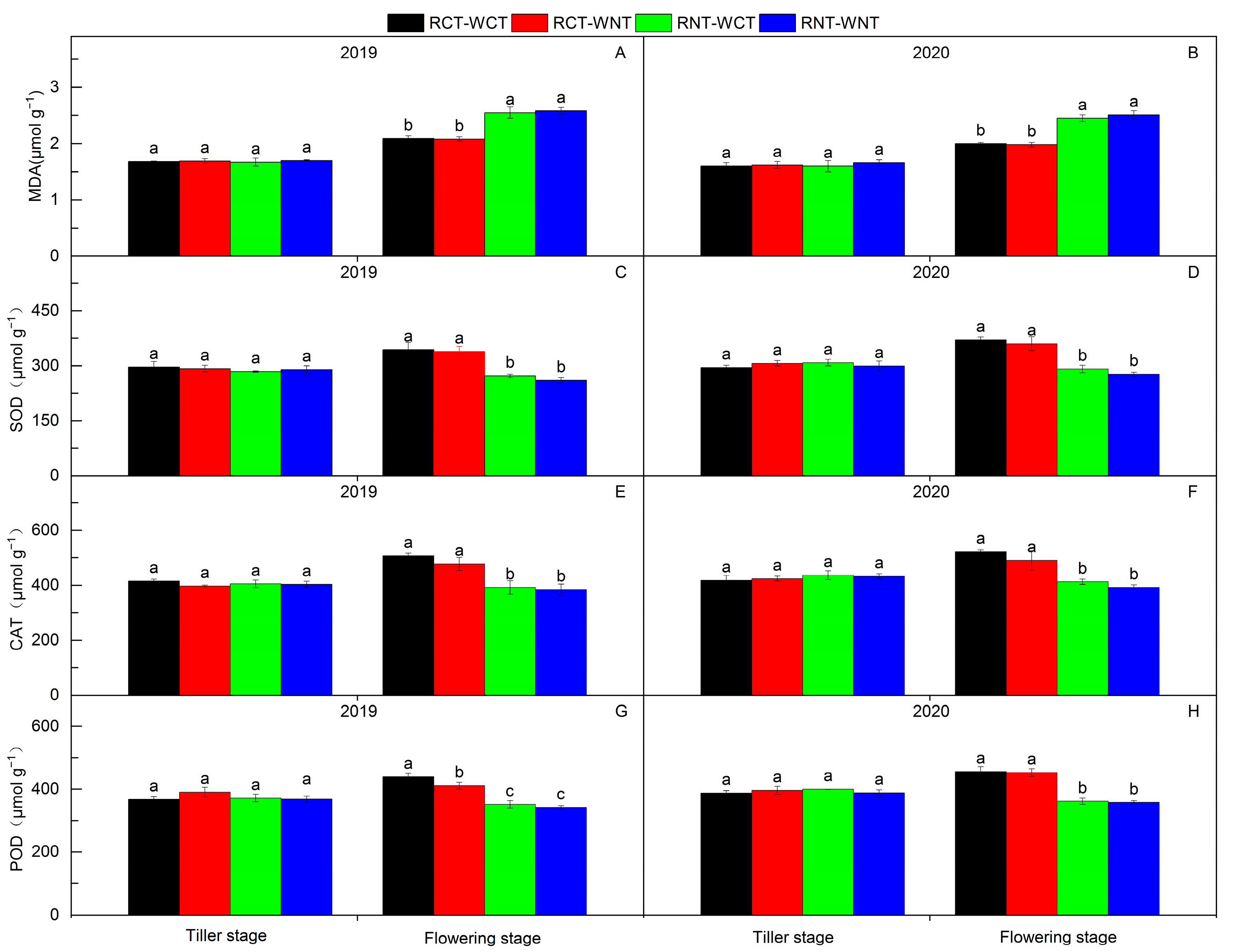Potential Application of Alternate Tillage (AT) in a Rice–Wheat Rotation System—Based on Soil Physical Properties, Wheat Growth and Yield
Abstract
:1. Introduction
2. Materials and Methods
2.1. Experimental Site
2.2. Experimental Treatments
2.3. Measurement Items and Methods
2.3.1. Wheat Yield and Yield Components
2.3.2. Bulk Density and Total Porosity of Soil
2.3.3. Wheat Root Function
2.3.4. Wheat Net Photosynthetic Rate and Leaf Area Index
2.3.5. Determination of Antioxidant Activities and Malondialdehyde Content in Wheat Leaves
2.4. Statistical Analyses
3. Results
3.1. Effects of Tillage on Physical Properties of Soil
3.2. Effects of Tillage on Root Activity and Root Dry Weight
3.3. Effects of Tillage on Net Photosynthetic Rate and Leaf Area Index
3.4. Effects of Tillage on MDA Content and Activities of SOD, CAT, and POD
3.5. Effects of Tillage on Yield and Yield Composition
4. Discussion
4.1. Bulk Density and Total Porosity of Soil
4.2. Root Function and Photosynthetic Capacity
4.3. MDA Content and Antioxidant Responses
4.4. Yield and Yield Composition
5. Conclusions
Author Contributions
Funding
Institutional Review Board Statement
Informed Consent Statement
Data Availability Statement
Conflicts of Interest
References
- Zuber, S.M.; Villamil, M.B. Meta-analysis approach to assess effect of tillage on microbial biomass and enzyme activities. Soil Biol. Biochem. 2016, 97, 176–187. [Google Scholar] [CrossRef]
- Wang, X.; Qi, J.-Y.; Zhang, X.-Z.; Li, S.-S.; Virk, A.L.; Zhao, X.; Xiao, X.-P.; Zhang, H.-L. Effects of tillage and residue management on soil aggregates and associated carbon storage in a double paddy cropping system. Soil Till. Res. 2019, 194, 104339. [Google Scholar] [CrossRef]
- Huang, M.; Zou, Y.; Jiang, P.; Xia, B.; Feng, Y.; Cheng, Z.; Mo, Y. Effect of tillage on soil and crop properties of wet-seeded flooded rice. Field Crop Res. 2012, 129, 28–38. [Google Scholar] [CrossRef]
- Saikia, R.; Sharma, S.; Thind, H.S.; Sidhu, H.; Singh, Y. Temporal changes in biochemical indicators of soil quality in response to tillage, crop residue and green manure management in a rice-wheat system. Ecol. Indic. 2019, 103, 383–394. [Google Scholar] [CrossRef]
- Wang, X.; Qi, J.Y.; Liu, B.Y.; Kan, Z.; Zhao, X.; Xiao, X.; Zhang, H. Strategic tillage effects on soil properties and agricultural productivity in the paddies of Southern China. Land Degrad. Dev. 2020, 31, 1277–1286. [Google Scholar] [CrossRef]
- Chavarria, D.N.; Pérez-Brandan, C.; Serri, D.L.; Meriles, J.M.; Restovich, S.B.; Andriulo, A.E.; Jacquelin, L.; Vargas-Gil, S. Response of soil microbial communities to agroecological versus conventional systems of extensive agriculture. Agric. Ecosyst. Environ. 2018, 264, 1–8. [Google Scholar] [CrossRef]
- Li, S.; Jiang, X.; Wang, X.; Wright, A.L. Tillage effects on soil nitrification and the dynamic changes in nitrifying microorganisms in a subtropical rice-based ecosystem: A long-term field study. Soil Till. Res. 2015, 150, 132–138. [Google Scholar] [CrossRef]
- Guo, L.; Zhang, L.; Liu, L.; Sheng, F.; Cao, C.; Li, C. Effects of long-term no tillage and straw return on greenhouse gas emissions and crop yields from a rice-wheat system in central China. Agric. Ecosyst. Environ. 2021, 322, 107650. [Google Scholar] [CrossRef]
- Jiang, X.; Wright, A.; Wang, J.; Li, Z. Long-term tillage effects on the distribution patterns of microbial biomass and activities within soil aggregates. Catena 2011, 87, 276–280. [Google Scholar] [CrossRef]
- Bogunovic, I.; Pereira, P.; Kisic, I.; Sajko, K.; Sraka, M. Tillage management impacts on soil compaction, erosion and crop yield in Stagnosols (Croatia). Catena 2018, 160, 376–384. [Google Scholar] [CrossRef]
- Dang, Y.P.; Moody, P.W.; Bell, M.J.; Seymour, N.P.; Dalal, R.C.; Freebairn, D.M.; Walker, S.R. Strategic tillage in no-till farming systems in Australia’s northern grains-growing regions: II. Implications for agronomy, soil and environment. Soil Till. Res. 2015, 152, 115–123. [Google Scholar]
- Dang, Y.P.; Seymour, N.P.; Walker, S.R.; Bell, M.J.; Freebairn, D.M. Strategic tillage in no-till farming systems in Australia’s northern grains-growing regions: I. Drivers and implementation. Soil Till. Res. 2015, 152, 104–114. [Google Scholar]
- Dang, Y.P.; Balzer, A.; Crawford, M.; Rincon-Florez, V.; Liu, H.; Melland, A.R.; Antille, D.; Kodur, S.; Bell, M.J.; Whish, J.P.M.; et al. Strategic tillage in conservation agricultural systems of north-eastern Australia: Why, where, when and how? Environ. Sci. Pollut. R 2018, 25, 1000–1015. [Google Scholar]
- Dai, J.; Hu, J.; Zhu, A.; Bai, J.; Wang, J.; Lin, X. No tillage enhances arbuscular mycorrhizal fungal population, glomalin-related soil protein content, and organic carbon accumulation in soil macroaggregates. J. Soil Sediment. 2015, 15, 1055–1062. [Google Scholar] [CrossRef]
- Hu, J.; Yang, A.; Wang, J.; Zhu, A.; Dai, J.; Wong, M.H.; Lin, X. Arbuscular mycorrhizal fungal species composition, propagule density, and soil alkaline phosphatase activity in response to continuous and alternate no-tillage in Northern China. Catena 2015, 133, 215–220. [Google Scholar] [CrossRef]
- Pandey, D.; Agrawal, M.; Bohra, J.S.; Adhya, T.; Bhattacharyya, P. Recalcitrant and labile carbon pools in a sub-humid tropical soil under different tillage combinations: A case study of rice–wheat system. Soil Till. Res. 2014, 143, 116–122. [Google Scholar] [CrossRef]
- Qin, X.; Zhang, F.; Liu, C.; Yu, H.; Cao, B.; Tian, S.; Liao, Y.; Siddique, K.H. Wheat yield improvements in China: Past trends and future directions. Field Crop. Res. 2015, 177, 117–124. [Google Scholar] [CrossRef]
- Yang, L.; Wang, Y.; Kobayashi, K.; Zhu, J.; Huang, J.; Yang, H.; Wang, Y.; Dong, G.; Liu, G.; Han, Y.; et al. Seasonal changes in the effects of free-air CO2 enrichment (FACE) on growth, morphology and physiology of rice root at three levels of nitrogen fertilization. Glob. Chang. Biol. 2008, 14, 1844–1853. [Google Scholar] [CrossRef]
- Tian, G.; Gao, L.; Kong, Y.; Hu, X.; Xie, K.; Zhang, R.; Ling, N.; Shen, Q.; Guo, S. Improving rice population productivity by reducing nitrogen rate and increasing plant density. PLoS ONE 2017, 12, e182310. [Google Scholar] [CrossRef]
- Huang, S.; Rao, G.; Ashraf, U.; He, L.; Zhang, Z.; Zhang, H.; Mo, Z.; Pan, S.; Tang, X. Application of inorganic passivators reduced Cd contents in brown rice in oilseed rape-rice rotation under Cd contaminated soil. Chemosphere 2020, 259, 127404. [Google Scholar] [CrossRef] [PubMed]
- Kong, F.; Chen, F.; Zhang, H.; Huang, G. Effects of rotational tillage on soil physical properties and winter wheat yield. Trans. Chin. Soc. Agric. Eng. 2010, 26, 150–155. [Google Scholar]
- Huang, M.; Liang, T.; Wang, L.; Zhou, C. Effects of no-tillage systems on soil physical properties and carbon sequestration under long term wheat-maize double cropping system. Catena 2015, 128, 195–202. [Google Scholar] [CrossRef]
- Biberdzic, M.; Barac, S.; Lalevic, D.; Djikic, A.; Prodanovic, D.; Rajicic, V. Influence of soil tillage system on soil compaction and winter wheat yield. Chil. J. Agric. Res. 2020, 80, 80–89. [Google Scholar] [CrossRef]
- Das, A.; Lal, R.; Patel, D.; Idapuganti, R.; Layek, J.; Ngachan, S.; Ghosh, P.; Bordoloi, J.; Kumar, M. Effects of tillage and biomass on soil quality and productivity of lowland rice cultivation by small scale farmers in North Eastern India. Soil Till. Res. 2014, 143, 50–58. [Google Scholar] [CrossRef]
- Roseberg, R.J.; McCoy, E.L. Tillage-and traffic-induced changes in macroporosity and macropore continuity: Air permeability assessment. Soil Sci. Soc. Am. J. 1992, 56, 1261–1267. [Google Scholar]
- Jiang, S.; Du, B.; Wu, Q.; Zhang, H.; Zhu, J. Increasing pit-planting density of rice varieties with different panicle types to improves sink characteristics and rice yield under alternate wetting and drying irrigation. Food Energy Secur. 2021, 3, e335. [Google Scholar] [CrossRef]
- Yang, H.; Wu, G.; Mo, P.; Chen, S.; Wang, S.; Xiao, Y.; Ma, H.A.; Wen, T.; Guo, X.; Fan, G. The combined effects of maize straw mulch and no-tillage on grain yield and water and nitrogen use efficiency of dry-land winter wheat (Triticum aestivum L.). Soil Till. Res. 2020, 197, 104485. [Google Scholar] [CrossRef]
- Guo, Y.; Yin, W.; Hu, F.; Fan, Z.; Fan, H.; Zhao, C.; Yu, A.; Chai, Q.; Coulter, J.A. Reduced irrigation and nitrogen coupled with no-tillage and plastic mulching increase wheat yield in maize-wheat rotation in an arid region. Field Crop. Res. 2019, 243, 107615. [Google Scholar]
- Guan, D.; Zhang, Y.; Al-Kaisi, M.M.; Wang, Q.; Zhang, M.; Li, Z. Tillage practices effect on root distribution and water use efficiency of winter wheat under rain-fed condition in the North China Plain. Soil Till. Res. 2015, 146, 286–295. [Google Scholar] [CrossRef]
- Jiang, S.; Du, B.; Wu, Q.; Zhang, H.; Deng, Y.; Tang, X.; Zhu, J. Selenium Decreases the Cadmium Content in Brown Rice: Foliar Se Application to Plants Grown in Cd-contaminated Soil. J. Soil Sci. Plant Nut. 2022, 22, 1033–1043. [Google Scholar]
- Du, P.; Luo, H.; He, J.; Mao, T.; Du, B.; Hu, L. Different tillage induces regulation in 2-acetyl-1-pyrroline biosynthesis in direct-seeded fragrant rice. BMC Plant Biol. 2019, 19, 308. [Google Scholar] [CrossRef] [PubMed]
- Yan, F.; Sun, Y.; Xu, H.; Yin, Y.; Wang, H.; Wang, C.; Guo, C.; Yang, Z.; Sun, Y.; Ma, J. Effects of wheat straw mulch application and nitrogen management on rice root growth, dry matter accumulation and rice quality in soils of different fertility. Paddy Water Environ. 2018, 16, 507–518. [Google Scholar] [CrossRef]
- Zhang, X.; Zhu, A.; Xin, X.; Yang, W.; Zhang, J.; Ding, S. Tillage and residue management for long-term wheat-maize cropping in the North China Plain: I. Crop yield and integrated soil fertility index. Field Crop. Res. 2018, 221, 157–165. [Google Scholar] [CrossRef]
- Zhang, L.; Zheng, J.; Chen, L.; Shen, M.; Zhang, X.; Zhang, M.; Bian, X.; Zhang, J.; Zhang, W. Integrative effects of soil tillage and straw management on crop yields and greenhouse gas emissions in a rice–wheat cropping system. Eur. J. Agron. 2015, 63, 47–54. [Google Scholar] [CrossRef]
- Omara, P.; Aula, L.; Eickhoff, E.M.; Dhillon, J.S.; Lynch, T.; Wehmeyer, G.B.; Raun, W. Influence of No-Tillage on Soil Organic Carbon, Total Soil Nitrogen, and Winter Wheat (Triticum aestivum L.) Grain Yield. Int. J. Agron. 2019, 2019, 9632969. [Google Scholar] [CrossRef]
- Shao, Y.; Xie, Y.; Wang, C.; Yue, J.; Yao, Y.; Li, X.; Liu, W.; Zhu, Y.; Guo, T. Effects of different soil conservation tillage approaches on soil nutrients, water use and wheat-maize yield in rainfed dry-land regions of North China. Eur. J. Agron. 2016, 81, 37–45. [Google Scholar] [CrossRef]
- Ding, J.; Li, S.; Hu, W.; Wu, J.; Yang, Y. Simulating the Effects of Conventional Tillage Versus No-Tillage on Nitrogen Uptake and Utilization of Winter Wheat with RZWQM2 in a 7-year Field Experiment. Int. J. Plant Prod. 2022, 16, 153–162. [Google Scholar] [CrossRef]
- Baumhardt, R.L.; Schwartz, R.C.; Jones, O.R.; Scanlon, B.; Reedy, R.; Marek, G. Long-term conventional and no-tillage effects on field hydrology and yields of a dryland crop rotation. Soil Sci. Soc. Am. J. 2017, 81, 200–209. [Google Scholar] [CrossRef]
- Ali, S.; Tedone, L.; Verdini, L.; Cazzato, E.; De Mastro, G. Wheat Response to No-Tillage and Nitrogen Fertilization in a Long-Term Faba Bean-Based Rotation. Agronomy 2019, 9, 50. [Google Scholar] [CrossRef]
- Guo, Y.; Yin, W.; Chai, Q.; Fan, Z.; Hu, F.; Fan, H.; Zhao, C.; Yu, A.; Coulter, J.A. No tillage with previous plastic covering increases water harvesting and decreases soil CO2 emissions of wheat in dry regions. Soil Till. Res. 2021, 208, 104883. [Google Scholar] [CrossRef]
- Guo, Y.; Yin, W.; Chai, Q.; Yu, A.; Zhao, C.; Fan, Z.; Fan, H.; Coulter, J.A. No tillage and previous residual plastic mulching with reduced water and nitrogen supply reduces soil carbon emission and enhances productivity of following wheat in arid irrigation areas. Field Crop. Res. 2021, 262, 108028. [Google Scholar] [CrossRef]
- Wang, Y.; Zhang, Y.; Zhou, S.; Wang, Z. Meta-analysis of no-tillage effect on wheat and maize water use efficiency in China. Sci. Total Environ. 2018, 635, 1372–1382. [Google Scholar] [CrossRef] [PubMed]




| Year | Tillage | Spike Number m−2 | Grains per Spike | 1000-Grain Weight | Yield |
|---|---|---|---|---|---|
| 2019 | RCT-WCT | 466.04 ± 16.45a | 33.97 ± 0.99a | 47.12 ± 0.61a | 7.29 ± 0.56a |
| RNT-WCT | 466.02 ± 21.68a | 33.23 ± 1.93a | 46.86 ± 0.43a | 7.1 ± 0.72a | |
| RCT-WNT | 451.51 ± 31.3a | 29.18 ± 0.83b | 44.85 ± 1.17b | 5.81 ± 0.53b | |
| RNT-RNT | 439.48 ± 17.29a | 28.38 ± 0.66b | 43.39 ± 0.27c | 5.31 ± 0.34b | |
| 2020 | RCT-WCT | 463.37 ± 13.22a | 33.12 ± 0.34a | 47.59 ± 0.35a | 7.15 ± 0.26a |
| RNT-WCT | 464.17 ± 41.5a | 32.73 ± 1.12a | 45.58 ± 0.62b | 6.77 ± 0.8a | |
| RCT-WNT | 436.73 ± 15.09a | 29.51 ± 0.79b | 45.39 ± 0.82b | 5.71 ± 0.15b | |
| RNT-RNT | 451.29 ± 11.97a | 28.38 ± 0.63b | 44.25 ± 1.01b | 5.54 ± 0.25b | |
| Year | * | ** | * | ** | |
| Tillage | ** | ** | ** | ** | |
| Year * Tillage | ns | ns | ns | ns | |
Publisher’s Note: MDPI stays neutral with regard to jurisdictional claims in published maps and institutional affiliations. |
© 2022 by the authors. Licensee MDPI, Basel, Switzerland. This article is an open access article distributed under the terms and conditions of the Creative Commons Attribution (CC BY) license (https://creativecommons.org/licenses/by/4.0/).
Share and Cite
Li, S.; Zhang, Y.; Guo, L.; Li, X. Potential Application of Alternate Tillage (AT) in a Rice–Wheat Rotation System—Based on Soil Physical Properties, Wheat Growth and Yield. Soil Syst. 2022, 6, 70. https://doi.org/10.3390/soilsystems6030070
Li S, Zhang Y, Guo L, Li X. Potential Application of Alternate Tillage (AT) in a Rice–Wheat Rotation System—Based on Soil Physical Properties, Wheat Growth and Yield. Soil Systems. 2022; 6(3):70. https://doi.org/10.3390/soilsystems6030070
Chicago/Turabian StyleLi, Shengchun, Yilin Zhang, Lihao Guo, and Xiaofang Li. 2022. "Potential Application of Alternate Tillage (AT) in a Rice–Wheat Rotation System—Based on Soil Physical Properties, Wheat Growth and Yield" Soil Systems 6, no. 3: 70. https://doi.org/10.3390/soilsystems6030070
APA StyleLi, S., Zhang, Y., Guo, L., & Li, X. (2022). Potential Application of Alternate Tillage (AT) in a Rice–Wheat Rotation System—Based on Soil Physical Properties, Wheat Growth and Yield. Soil Systems, 6(3), 70. https://doi.org/10.3390/soilsystems6030070






